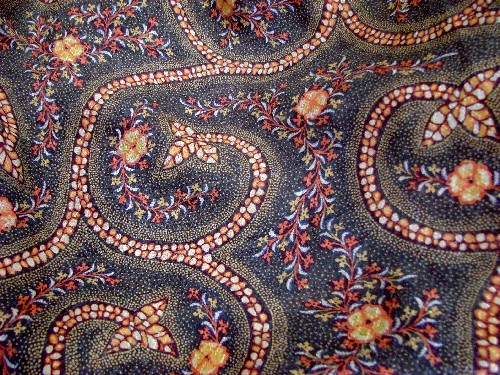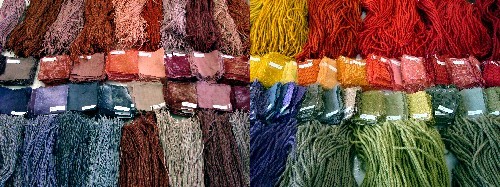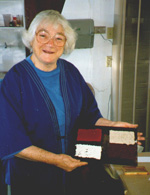Maiwa Handprints' Natural Dye Workshop
By Elizabeth Smith
We gathered around a table engulfed in a smorgasbord of colors, the usual sweets and foodstuff replaced by sumptuous silks and saris. The sixteen of us had assembled together to begin a four-day workshop on natural dyes at the Maiwa East workroom in Vancouver Canada, hoping to deepen our knowledge of botanical textiles and thicken our cookbooks with recipes for concocting colors.

An earth-toned binder filled with details on the historical, cultural, botanical and technical aspects of natural dyes marked each place setting. More than 70 color recipes were included, all of which we'd be testing in class with the guidance of Charllotte Kwon, our instructor and founder of Maiwa Handprints.
"Maiwa (pronounced my-wa) means 'beautiful language' in Chinese," Kwon said, signaling the start of the day, "A language spoken through the work of artisans all over the world."
Maiwa Handprints is a business focused on preserving this global language by reviving the knowledge and practice of high-quality craftwork, a goal it partly achieves through its annual fall workshops, which serve two purposes:
• To teach students a particular craft technique in order to ensure both its continuation and evolution through students' creative interpretations.
• To educate students on the extensive time and skill involved in a particular technique, which in turn creates well-informed consumers who are willing to pay artisans a high price for their hand crafted pieces.
Kwon traverses the globe—most often travelling to India—buying exquisitely detailed textiles, furniture and jewelry from cooperatives to sell at the Maiwa Handprints store in Granville Island, as well as online at www.maiwa.com. By giving third world artisans access to a western market, Kwon has made it possible for them to sell their expertly crafted pieces for a much higher price than they would make at their local souk, which provides them with a livable income and ensures that their craft continues.

"We don't like a 'make it and take it' workshop," Kwon said, explaining what the workshops are meant to accomplish. "We want students to take away a greater understanding of a skill and what the artist puts into it so they can realize its value and ensure its survival through their own work or by paying a fair price for the work of others."
The workshops, typically two to five days in length, beginning in September and running through November, are held together by a single theme, which this year was natural dyes. "Natural dyes were either the focus of the class, such as 'The Organic Indigo Vat,' or an important component," Kwon said.
In Kwon's class, we began our modern-day journey into the world of lost color with a video about the history of natural dyes, originating 15,000 years ago through the use of colored muds on cave walls. Natural colors, all but silenced in many areas after 1856 with the introduction of chemical dyes, played an important role in the economic success of ancient civilizations, with alum deposits in Italy largely funding the Crusades and cochineal bugs yielding higher profits than gold for the Spanish!
After the video, we spent the rest of the day mordanting hemp, alpaca, wool, linen, cotton, silk rayon and silk rayon velvet. For cellulose fibers we mordanted with 8% tannin (oak galls), simmered for 45 minutes, then added 15% alum and simmered for another 45 minutes. For protein fibers we used 15% alum and held for an hour under a simmer.
The next morning, Kwon assigned us different measures of crushed roots, insects, fruits, leaves, flowers and woods, which we cooked in different combinations to create a total of 64 colors! Each individual worked with four dye pots, going from one to the next after Kwon took a peek and a couple sniffs to determine if the dye had set. No thermometers were available, so we utilized our senses to judge the temperatures of our baths, relying more heavily on sight than touch (ouch that's hot).


With sixteen pots simmering at once, the choice to hold Maiwa's workshop series in the fall revealed itself as the mark of scheduling genius, as we all appreciated the constant flow of cool fresh air through the workroom's open windows. Aside from the autumn breezes, workshops are held back to back in the fall to bring together a broader range of students.
"This format attracts a lot of out-of-towners because more courses can be taken in a shorter period of time," Kwon said. "In the past, only locals could attend the weekend format and now the workshops are more accessible to everyone."
Representing folks from down the street to downtown Chicago, our class spent the third day of the workshop recovering from the previous day's dyeing extravaganza by learning about different Shibori stitching techniques. As we stitched on a variety of different scarves provided by Maiwa, we watched In Search of Lost Color, a documentary on different dye techniques.
On the final day of the course we paired up and prepared an indigo vat using the recipe included in our binders. We dipped the scarves we had carefully hand stitched the day before, as well as a plethora of cotton swatches, some white and some previously dyed, to extend the color range from the indigo vat. We watched one last documentary by Maiwa, entitled Indigo: A World of Blue, and ended the afternoon cutting out the stitches from our blue scarves to reveal gorgeous patterns and gradations of blue.

Kwon's Natural Dye workshop is held every fall, its content slightly modified according to the theme of the workshop series. The theme in 2011 will be "Story Cloths," textiles that tell tales of the lives of men and women from cultures as diverse as the colors from nature.
Registration for the 2011 workshop series will begin in the spring. If interested, be sure to sign up quickly. "Our classes sell out," Kwon said. "Many of our teachers are internationally known, have written books, and are experts of a technique. Our courses are known for their exceptional content."
For more information on natural dye workshops and materials available at Maiwa, visit www.maiwa.com.
 Turkey Red Journal
Turkey Red Journal
